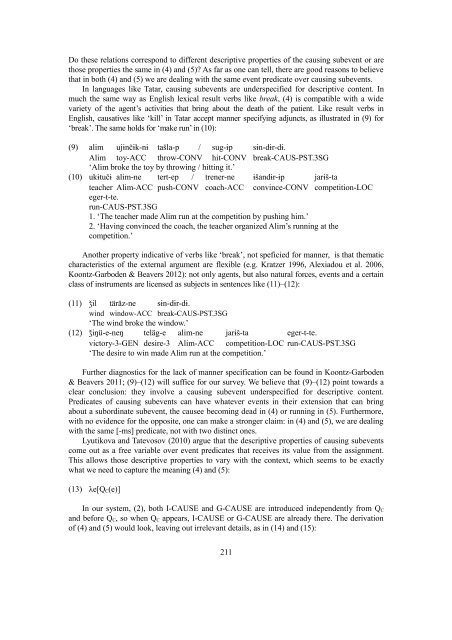Empirical Issues in Syntax and Semantics 9 (EISS 9 ... - CSSP - CNRS
Empirical Issues in Syntax and Semantics 9 (EISS 9 ... - CSSP - CNRS
Empirical Issues in Syntax and Semantics 9 (EISS 9 ... - CSSP - CNRS
You also want an ePaper? Increase the reach of your titles
YUMPU automatically turns print PDFs into web optimized ePapers that Google loves.
Do these relations correspond to different descriptive properties of the caus<strong>in</strong>g subevent or are<br />
those properties the same <strong>in</strong> (4) <strong>and</strong> (5)? As far as one can tell, there are good reasons to believe<br />
that <strong>in</strong> both (4) <strong>and</strong> (5) we are deal<strong>in</strong>g with the same event predicate over caus<strong>in</strong>g subevents.<br />
In languages like Tatar, caus<strong>in</strong>g subevents are underspecified for descriptive content. In<br />
much the same way as English lexical result verbs like break, (4) is compatible with a wide<br />
variety of the agent’s activities that br<strong>in</strong>g about the death of the patient. Like result verbs <strong>in</strong><br />
English, causatives like ‘kill’ <strong>in</strong> Tatar accept manner specify<strong>in</strong>g adjuncts, as illustrated <strong>in</strong> (9) for<br />
‘break’. The same holds for ‘make run’ <strong>in</strong> (10):<br />
(9) alim ujɨnčɨk-nɨ tašla-p / sug-ɨp sɨn-dɨr-dɨ.<br />
Alim toy-ACC throw-CONV hit-CONV break-CAUS-PST.3SG<br />
‘Alim broke the toy by throw<strong>in</strong>g / hitt<strong>in</strong>g it.’<br />
(10) ukɨtučɨ alim-ne tert-ep / trener-ne ɨš<strong>and</strong>ɨr-ɨp jarɨš-ta<br />
teacher Alim-ACC push-CONV coach-ACC conv<strong>in</strong>ce-CONV competition-LOC<br />
eger-t-te.<br />
run-CAUS-PST.3SG<br />
1. ‘The teacher made Alim run at the competition by push<strong>in</strong>g him.’<br />
2. ‘Hav<strong>in</strong>g conv<strong>in</strong>ced the coach, the teacher organized Alim’s runn<strong>in</strong>g at the<br />
competition.’<br />
Another property <strong>in</strong>dicative of verbs like ‘break’, not speficied for manner, is that thematic<br />
characteristics of the external argument are flexible (e.g. Kratzer 1996, Alexiadou et al. 2006,<br />
Koontz-Garboden & Beavers 2012): not only agents, but also natural forces, events <strong>and</strong> a certa<strong>in</strong><br />
class of <strong>in</strong>struments are licensed as subjects <strong>in</strong> sentences like (11)–(12):<br />
(11) ǯil täräz-ne sɨn-dɨr-dɨ.<br />
w<strong>in</strong>d w<strong>in</strong>dow-ACC break-CAUS-PST.3SG<br />
‘The w<strong>in</strong>d broke the w<strong>in</strong>dow.’<br />
(12) ǯiŋü-e-neŋ teläg-e alim-ne jarɨš-ta eger-t-te.<br />
victory-3-GEN desire-3 Alim-ACC competition-LOC run-CAUS-PST.3SG<br />
‘The desire to w<strong>in</strong> made Alim run at the competition.’<br />
Further diagnostics for the lack of manner specification can be found <strong>in</strong> Koontz-Garboden<br />
& Beavers 2011; (9)–(12) will suffice for our survey. We believe that (9)–(12) po<strong>in</strong>t towards a<br />
clear conclusion: they <strong>in</strong>volve a caus<strong>in</strong>g subevent underspecified for descriptive content.<br />
Predicates of caus<strong>in</strong>g subevents can have whatever events <strong>in</strong> their extension that can br<strong>in</strong>g<br />
about a subord<strong>in</strong>ate subevent, the causee becom<strong>in</strong>g dead <strong>in</strong> (4) or runn<strong>in</strong>g <strong>in</strong> (5). Furthermore,<br />
with no evidence for the opposite, one can make a stronger claim: <strong>in</strong> (4) <strong>and</strong> (5), we are deal<strong>in</strong>g<br />
with the same [-ms] predicate, not with two dist<strong>in</strong>ct ones.<br />
Lyutikova <strong>and</strong> Tatevosov (2010) argue that the descriptive properties of caus<strong>in</strong>g subevents<br />
come out as a free variable over event predicates that receives its value from the assignment.<br />
This allows those descriptive properties to vary with the context, which seems to be exactly<br />
what we need to capture the mean<strong>in</strong>g (4) <strong>and</strong> (5):<br />
(13) λe[Q C (e)]<br />
In our system, (2), both I-CAUSE <strong>and</strong> G-CAUSE are <strong>in</strong>troduced <strong>in</strong>dependently from Q C<br />
<strong>and</strong> before Q C , so when Q C appears, I-CAUSE or G-CAUSE are already there. The derivation<br />
of (4) <strong>and</strong> (5) would look, leav<strong>in</strong>g out irrelevant details, as <strong>in</strong> (14) <strong>and</strong> (15):<br />
211











